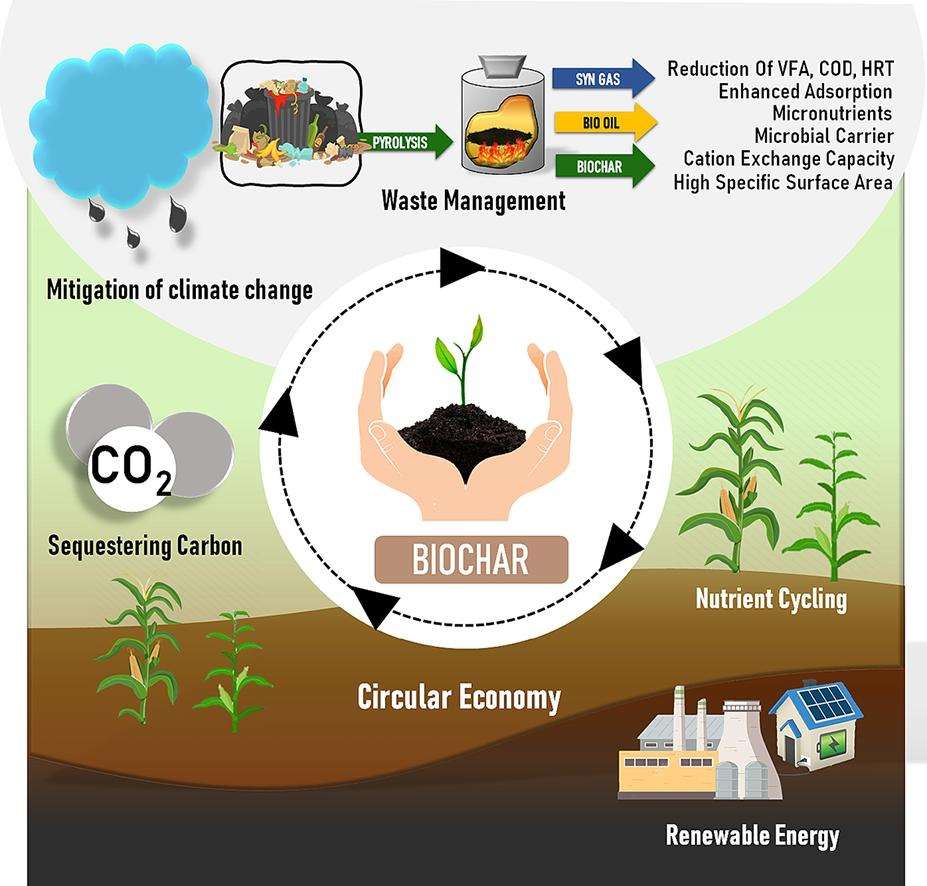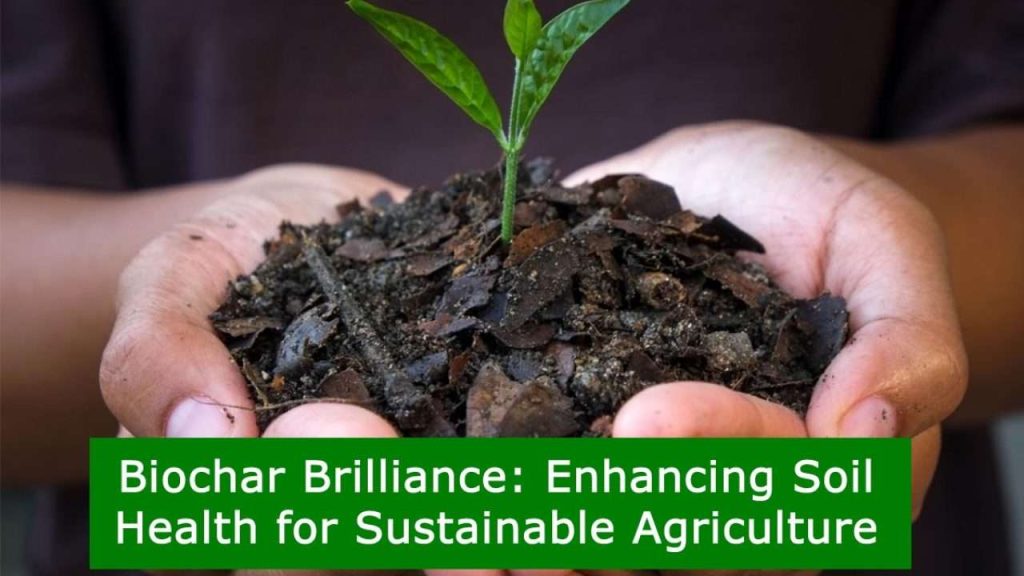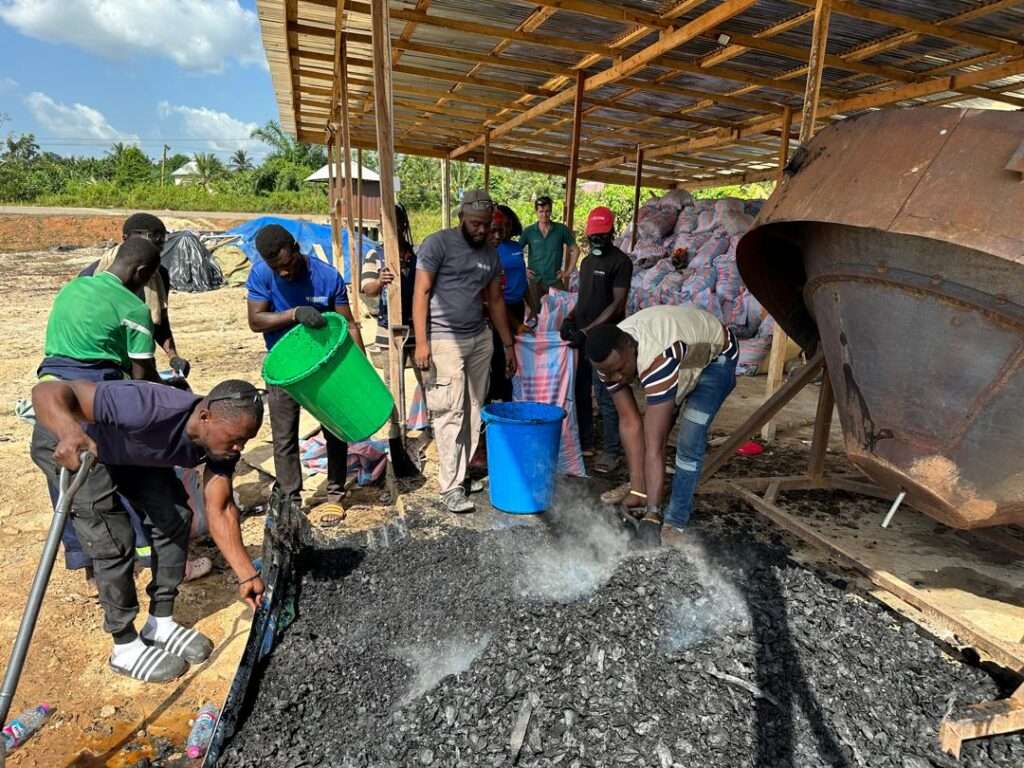Biochar is a carbon-rich substance that does not degrade in the soil even when left there for millennia. It can also be used as a renewable energy resource. Biochar’s high stability and potential use in carbon sequestration inspired the combustion-based sequestration of carbon-based materials. Because of its capacity to trap carbon with little effort, it is a useful tool in the fight against climate change. Biochar may improve the agricultural output of acidic soils by increasing soil fertility. Soil aeration, nutrient availability, and water filtering are all boosted when biochar is applied to the ground (Manikandan, 2023).

Framework of Biochar.
Source: Science Direct
What is Biochar?
Biochar is a high-carbon material that resembles charcoal and is produced by burning organic materials in a low-oxygen environment (Shoudho et al., 2024). This material, derived after the combustion of feedstock under minimal or no oxygen supply, is considered a potential soil conditioner (Ayaz et al., 2021). Biochar as a renewable energy resource doesn’t easily escape into the atmosphere (Spears, 2018). Furthermore, biochar supports a zero-waste strategy and circular economy by converting biomass waste into valuable resources, improving soil health, and generating renewable energy (Nascimento et al., 2022).
Source: Carbon Credits
What is pyrolysis?
Pyrolysis is a chemical process in which organic materials (such as biomass, plastic, or rubber) are decomposed by heating them either in the absence of oxygen or in a very limited supply of oxygen. Pyrolysis occurs at high temperatures, usually between 400°C to 800°C (Prurapark et al., 2022), but without the presence of oxygen (Upadhyay et al., 2024). The products obtained from the pyrolysis process can be divided into three types according to the condition. The primary products are gas, liquid (which has oil-like properties), and char. The ratio of obtained products depends on the processing conditions, such as temperature, heat rate, etc. (Prurapark et al., 2022).
Benefits of Biochar as renewable energy
Biochar as a renewable energy resource has economic, environmental, and social impacts.
Economic Benefits of Biochar
Biochar benefits the economy by improving soil health, providing energy sources, and generating income through carbon offsets in cap-and-trade markets (Schahczenski, 2018).
Environmental Benefits of Biochar
Biochar enhances the environment by reducing greenhouse gas emissions and improving soil health. It traps carbon in the soil, preventing its release into the atmosphere and aiding climate change mitigation. Furthermore, biochar increases soil fertility, promotes water retention, and supports plant growth, creating a positive feedback loop for CO₂ absorption. Additionally, biochar serves as an eco-friendly alternative to microplastic ion-exchange beads and coal-based activated charcoal, effectively filtering out metal and organic contaminants from water (You et al., 2020; Biochar International).
Social Benefits of Biochar
Biochar systems are an important tool to enhance food security by improving soil health and complementing existing regenerative and climate-smart agricultural practices. Biochar systems can support local communities by providing a use for agricultural residues, reducing the practice of crop burning, offering economic development with resources that may otherwise be wasted, and helping improve agricultural yields via enhanced soil health and water retention.
Source: Biochar Revolution
Biochar as a Renewable Energy resource
Biochar serves as an efficient, abundant, and easy-to-use material with diverse applications as a biofuel (Schahczenski, 2018; Asghar et al., 2022). It converts waste to fuel and carbon sinks, captures gases for liquid fuel, and burns cleaner than charcoal in stoves (ResourceWise,2023) (Zareef et al., 2022). Biomass generates heat directly or as biofuel, with forest residues like dead trees and branches converted into methane, ethanol, or biodiesel (Worku et al., 2024)
Source: Worku et al., 2024
Biochar as a Renewable Energy Source: Mitigating Climate Change
Biochar traps carbon and reduces greenhouse gases from waste, livestock, and soil, actively helping mitigate climate change as a renewable resource through the following methods (Upadhyay et al., 2024):
Carbon Sequestration
Carbon sequestration refers to the capture and long-term storage of carbon dioxide from the atmosphere to prevent its release. Biochar doesn’t break down easily, making it great for trapping carbon. It stores carbon dioxide for a long time and keeps it from going into the air.
Reducing Greenhouse Gas Emissions
Biochar effectively reduces greenhouse gases like CO₂, CH₄, and N₂O from agroecosystems. Specifically, biochar has a high surface area, which allows it to adsorb gases and reduce their release into the atmosphere (Upadhyay et al., 2024).
Enhancing Soil Fertility
Healthy agricultural soils support global food security by stabilising crop yields, while agronomic investments boost climate resilience and yield stability (Wolf et al., 2023). Biochar improves soil fertility and reduces nutrient loss by increasing nutrient availability in the soil (Upadhyay et al., 2024).
Improving Water Retention in Soils
Water management is vital for climate change mitigation (Gocer et al., 2024). Notably, biochar enhances soil moisture retention, thereby boosting crop yield. Its porous structure allows for prolonged water storage, while its fine particles create tight soil pores, effectively holding water against gravity (https://char-grow.com). This attribute of biochar lessens the effects of drought on crop productivity in drought-prone areas (Schahczenski, 2018).
Sustainable Waste Management
Biochar helps waste management by turning organic waste, like plants and food scraps, into a stable material. Using biochar in waste management solves problems with organic waste by turning waste into biochar. It also captures carbon, helping to reduce greenhouse gas emissions and contribute to climate change mitigation (Shoudho et al., 2024).
Promoting Renewable Energy
Biochar has potential as a source of renewable fuel in the energy sector (Upadhyay et al., 2024). Biochar can be a good source of renewable energy. It produces heat, electricity, and biofuels through special processes and helps reduce the use of fossil fuels, supporting cleaner energy (Anokye et al., 2024).
Supporting Sustainable Agriculture
Biochar supports sustainable agriculture by improving soil health. It helps retain water, nutrients, and soil structure, making it easier for plants to grow. It also reduces the need for chemical fertilizers, which can harm the environment. Additionally, it helps mitigate climate change (Ayaz et al., 2021).
Source: SlideShare
Biochar as a Renewable Energy Source: Sustainable Agriculture
Biochar is increasingly recognised as an environmentally friendly material that actively supports sustainable agriculture. Moreover, as a pyrolytic product of biomass, biochar has been reported to increase crop yield, mitigate climate change, and facilitate environmental restoration. Besides biochar, pyrolysis of plant materials also produces volatile chemicals in the form of smoke, which are found to be valuable biostimulants that enhance crop performance (Cao.,2022).

Biochar’s Role in Sustainable Agriculture.
Source: Plants Information
Case Study: Biochar as a Renewable Energy Source in Ghana
Biochar as a renewable energy source in Ghana’s fight against climate change is significant. Not only does biochar aid in cutting greenhouse gas emissions, but it also improves soil health by boosting fertility and enhancing water retention. These combined benefits make biochar a valuable tool in the efforts to slow climate change.

Biochar in Ghana.
Source: Solidaridad
Linking Biochar as A Renewable Energy to the UN SDGs
SDG2: Zero Hunger and Biochar
SDG2 aims to end poverty in all its forms everywhere. Biochar and bio-oils provide food security by producing agricultural inputs from harvest residues and food waste at the source. Ultimately, growing more food, especially in poor soils with increasingly erratic climate conditions, effectively reduces hunger.
SDG12: Responsible Consumption and Production of Biochar
SDG12 aims to ensure sustainable consumption and production patterns, which is key to sustaining the livelihoods of current and future generations. Our planet is running out of resources, but populations growing exponentially. The global population is likely to reach 9.8 billion by 2050. We need to change our consumption habits and shift our energy supplies to more sustainable ones. Converting waste into biochar actively replaces high-carbon, non-renewable, and costly materials. Consequently, this shift helps move us from a linear economy to a more circular one. Incorporating biochar into waste management techniques effectively tackles the issues associated with organic waste disposal, consistent with SDG12, (Shoudho et al., 2024).
SDG13: Climate Action and Biochar
Applying biochar to agriculture reduces global warming by lowering greenhouse gas emissions and storing atmospheric carbon in the soil, supporting climate action (Qambrani et al., 2017).
SDG15: Life on Land and Biochar
Biochar helps mitigate climate change by storing carbon for prolonged periods. Hence, there is a reduction in overall greenhouse gas emissions. The adoption of this technique in agricultural soils not only enhances soil fertility, water retention, and nutrient cycling but also promotes higher crop productivity, in line with SDG2 (Zero Hunger) and SDG15 (Life on Land)(Shoudho et al., 2024). Reclamation, remediation, and restoration are all ways that biochar can improve life on land (https://fingerlakesbiochar.com).
Moving Forward: Biochar as a Renewable Energy Resource
Using biochar to combat climate change and promote renewable energy requires integrating environmental, social, and economic strategies. The rapid rise in greenhouse gas emissions emphasises the urgent need for affordable and sustainable technologies to reduce emissions and store carbon in the soil. The 2018 IPCC report highlights biochar as a promising negative emission technology (NET) with great potential.
Policymakers must support biochar initiatives, particularly in rural areas where communities can easily access raw materials for production. These efforts boost economic growth, strengthen local communities, and reduce climate vulnerabilities. By using biochar as a renewable energy source, we actively align with multiple Sustainable Development Goals, making it an effective tool in addressing climate change.
Conclusion: Biochar as a Renewable Energy Resource
For far too long, the international community has struggled to address the escalating threats of climate change, population growth, and resource depletion. It is time for that to change. These challenges demand coordinated action and innovative solutions, such as adopting Biochar as a Renewable Energy Resource. Only by tackling these issues together can we secure a sustainable future for humanity.
The THRIVE Framework is a Holistic Regenerative Innovative Value Entity Framework. At THRIVE, our Tribe advocates for a better future, which is not only sustainable but going beyond this to demand a Thrivable Earth. Our framework integrates 12 Foundational Focus areas which work in tandem with one another. Unlike sustainability, which focuses mainly on environmental and social issues, thrivability goes further, aiming to help humanity avoid planetary destruction and create a thriving world. All in all, helping us measure sustainability and create a clear picture for future paths towards thrivability.
- Regenerative Economy: The Biochar system promotes a regenerative approach by recycling materials, composting waste, and encouraging self-sufficiency.
- Multi-Capital: Biochar system supports both environmental and economic value by improving soil health and reducing emissions.
- Finite Resources: Biochar minimises dependence on finite resources by smartly and efficiently using waste to maximise the value of limited materials.
- Systems Thinking: The Biochar system integrates energy, waste, water, and soil systems, taking a holistic approach to address interconnected challenges.
A Thrivable Future
To explore the concept of thrivability further, visit our website. Here you’ll find a wealth of resources, including blog posts, whitepapers, and free monthly webinars. Stay connected with the latest updates from the THRIVE Project by following us on LinkedIn. The THRIVE Project is always open to new collaboration opportunities. If you’re interested in exploring how our organisation can support your goals, don’t hesitate to get in touch. We’d love to work together towards creating a thriving future.
Subscribe to the free newsletter to stay informed about thrivability. Explore the informative podcast series.























